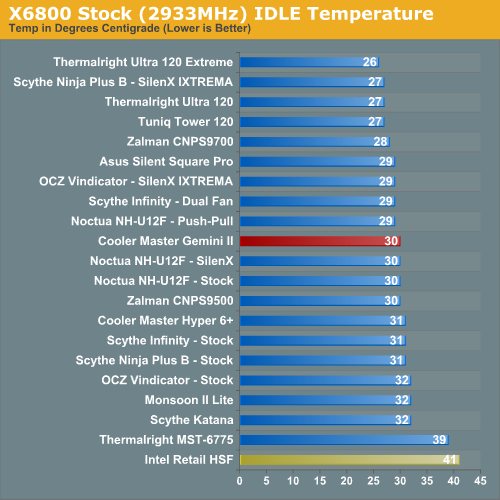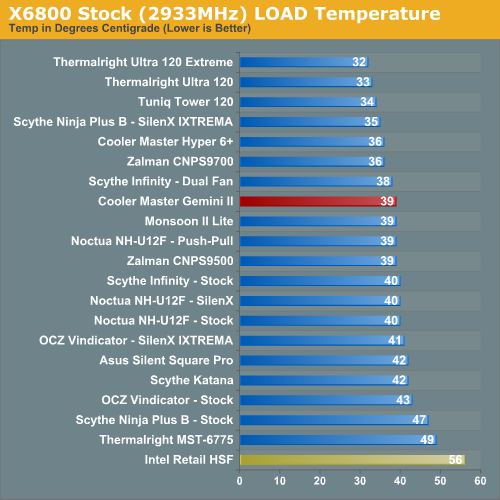Cooler Master GeminII: Performer or Poser?
by Wesley Fink on April 30, 2007 2:00 AM EST- Posted in
- Cases/Cooling/PSUs
Cooling at Stock Speed
Some users will never overclock their CPU, but they still want to run the coolest CPU temperatures possible to enhance stability and extend CPU life. The Cooler Master GeminII does not come with fans, so we tested with four fan configurations as detailed on page four. Since there was little difference in performance among the four fan configurations results are reported with the dual Noctua SF12 configuration. This was the only tested configuration that managed to hold noise below the system noise floor while still cooling at temperatures very close to the high-output 110+63CFM fan configuration.

Where the very good Intel stock cooler keeps the X6800 at 41C at idle, the CoolerMaster GeminII manages 30C in most fan configurations. This is a significant improvement over the Intel stock cooler performance, but it is still far from the best we have tested. The Thermalright coolers, at the top of our heatpipe tower performance charts, cool to 26C and 27C, and the Tuniq 120 maintains 27C. The GeminII is obviously not the best stock idle cooler we have tested, but it is broadly competitive.
It is more difficult to effectively simulate a computer being stressed by all of the conditions it might be exposed to in different operating environments. For most home users CPU power is most taxed with contemporary gaming. Therefore our stress test simulates running a demanding contemporary game. The Far Cry River demo is looped for 30 minutes and the CPU temperature is captured at four second intervals with the NVIDIA monitor "logging" option. The highest temperature during the load test is then reported. Momentary spikes are ignored, as we report a sustained high-level temp that you would expect to find in this recording configuration.
Cooling efficiency of the GeminII was compared under load conditions at stock speed to the retail HSF and other recently tested CPU coolers.

The GeminII under load at stock speeds reached a maximum temperature of 39C with most fan configurations. Best performance was with a Silverstone 110CFM fan plus Scythe SFLEX configuration at 38C. This was only 1C cooler with a big increase in noise. This performance compares to the Thermalright coolers at 32C and 33C, the Tuniq at 34C and the Cooler Master Hyper 6+ and Zalman 9700 at 36C. Stock load performance is average at best among tested coolers.
Some users will never overclock their CPU, but they still want to run the coolest CPU temperatures possible to enhance stability and extend CPU life. The Cooler Master GeminII does not come with fans, so we tested with four fan configurations as detailed on page four. Since there was little difference in performance among the four fan configurations results are reported with the dual Noctua SF12 configuration. This was the only tested configuration that managed to hold noise below the system noise floor while still cooling at temperatures very close to the high-output 110+63CFM fan configuration.

Where the very good Intel stock cooler keeps the X6800 at 41C at idle, the CoolerMaster GeminII manages 30C in most fan configurations. This is a significant improvement over the Intel stock cooler performance, but it is still far from the best we have tested. The Thermalright coolers, at the top of our heatpipe tower performance charts, cool to 26C and 27C, and the Tuniq 120 maintains 27C. The GeminII is obviously not the best stock idle cooler we have tested, but it is broadly competitive.
It is more difficult to effectively simulate a computer being stressed by all of the conditions it might be exposed to in different operating environments. For most home users CPU power is most taxed with contemporary gaming. Therefore our stress test simulates running a demanding contemporary game. The Far Cry River demo is looped for 30 minutes and the CPU temperature is captured at four second intervals with the NVIDIA monitor "logging" option. The highest temperature during the load test is then reported. Momentary spikes are ignored, as we report a sustained high-level temp that you would expect to find in this recording configuration.
Cooling efficiency of the GeminII was compared under load conditions at stock speed to the retail HSF and other recently tested CPU coolers.

The GeminII under load at stock speeds reached a maximum temperature of 39C with most fan configurations. Best performance was with a Silverstone 110CFM fan plus Scythe SFLEX configuration at 38C. This was only 1C cooler with a big increase in noise. This performance compares to the Thermalright coolers at 32C and 33C, the Tuniq at 34C and the Cooler Master Hyper 6+ and Zalman 9700 at 36C. Stock load performance is average at best among tested coolers.










44 Comments
View All Comments
Martimus - Monday, April 30, 2007 - link
It seems that turning the fans around would make more sense, considering that the airflow through the fins would be the same, but it wouldn't be blowing the hot air back onto the chip like it does in the configuration you show.pannivas - Monday, April 30, 2007 - link
This is a good cooler for an HTPC system. Because it performed OK in cooling (no OC), it's short and can fit in most HTPC cases (106.5mm including fans), and it can also be very silent by using one or two Noctua NF-S12 fans.thanks for the review
Jedi2155 - Monday, April 30, 2007 - link
Wow!Have you been running that CPU @ 1.5875 volts for 24/7 usage or do you just put it that high during your heatsink testing? Is it safe?
I also have a 680i, and have trouble getting 3.6 GHz stable with around 1.55 volts, but I'm afraid of putting it higher than that on my Tuniq 120 as I plan on keeping my CPU for a few years.
Jodiuh - Monday, April 30, 2007 - link
Thanks guys, looks like I'll hang w/ the Tuniq + Scythe SFLEX E for a bit longer and keep cooling the RAM/NB w/ a "wall" of 120's.